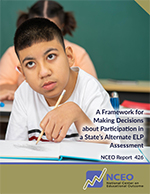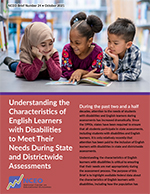NCEO recently published two products on the assessment of English learners with disabilities. As states focus on educational equity issues, these documents provide suggestions for ensuring English learners with disabilities are appropriately included in state assessments.
Determining whether an English learner with significant cognitive disabilities should participate in an alternate English language proficiency (alt-ELP) assessment is a challenge for Individualized Education Program (IEP) teams. Although some states provide guidelines for making the decision, many do not. A Framework for Making Decisions about Participation in a State’s Alternate ELP Assessment (NCEO Report #426) provides information on how to identify English learners who may have a most significant cognitive disability and are eligible to take an alt-ELP assessment. It does this in several ways. First, it summarizes the federal assessment requirements for English learners with the most significant cognitive disabilities. Second, it provides an overview of what is known about the characteristics of students with the most significant cognitive disabilities, English learners, and English learners with the most significant cognitive disabilities. Third, it offers a framework for identifying English learners with the most significant cognitive disabilities who are eligible to participate in the alt-ELP assessment. The framework includes guiding questions and vignettes of example decisions. Fourth, the resource lists additional considerations for ensuring that students are accurately identified and supported. The report includes a list of publications and key organizations with information on identifying English learners with the most significant cognitive disabilities.
The population of English learners with disabilities is growing faster than either the population of English learners or students with disabilities overall. However, the size of this student group and the growth rate can vary considerably by state. Understanding the Characteristics of English Learners with Disabilities to Meet Their Needs During State and Districtwide Assessments (Brief #24) presents data showing that English learners appear more likely than fluent English speaking students to be identified with particular types of disabilities. Data also show a slow but steady increase in the percentage of English learners with disabilities learning in general education classrooms for 80% or more of the school day. The assessment implications of these findings are also discussed:
- The increases in the population, as well as the percentage of English learners with disabilities in many states, increases the need for professional development on the characteristics of these students and how to meet their education needs.
- It is important that IEP teams understand how to assign English learners with disabilities to statewide accountability assessments.
- There is a need for policies on accessibility features and accommodations for English learners with disabilities.
- There continues to be a need to examine the settings in which English learners with disabilities receive instruction.


